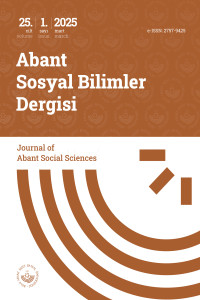Abstract
XI. yüzyıl Bizans tarihi açısından imparatorluğun en ilginç yüzyılıdır. Zira bu yüzyıl içinde devlet en güçlü zamanını yaşarken, aynı yüzyıl içinde büyük bir çöküş de yaşamıştır. Batıdan Normanların gelmesi, doğudan Selçuklu Türklerinin gelmesi imparatorluğu iki büyük güç arasında bırakmıştır. Malazgirt bozgunundan sonra Bizans güçsüzlüğünün farkına varmış ve çevresindeki güçlü devletler ile ittifak kurmaya çalışmıştır. Bu dönemde devlet içerisinde önemli bir konumda olan büyük alim Psellos da vazifesi gereği devletine ittifaklar bulmakta yardımcı olmuştur. Bu ittifakı bulmaya çalışırken de kendi toplumunun ve dininin özelliklerini karşı tarafa tanıtmak istemiştir. Burada çevirisini sunduğumuz Psellos’un bu mektubu, doğudaki bir sultana yazılmıştır. Biz çeviri metni sunarken ayrıca bu mektubun hangi devlete, hangi sultana ve hangi tarihte yazıldığına dair kendi görüşlerimizi sunacağız.
References
- Anne Comnène, Alexiade, c.I, çev: Bernard Leib, Paris: Les Belles Lettres, 1937. Başkumandan Simbat, Bir Ermeni Komutanın Kaleminden Ermeniler, çev: Engin Öztürk, İstanbul: Sarmal, 2024.
- Gautier Paul, Lettre au sultan Malik-shah rédigée par Michel Psellos, Revue des études byzantines, S. 35, 1977.
- Gautier Paul, “Deux Manuscrits Pselliens: Le Parisinus Graecus 1182 et le Laurentianus Graecus 57-40”, Revue des études byzantines, 1986, 44.
- Herbermann Charles George, The Catholic encyclopedia, c.12, New York: The Encyclopedia Press, 1907.
- Kaldellis Anthony, Mother and Sons, Fathers and Daughters: The Byzantine Family of Michael Psellos, Indiana: University of Notre Dame Press, 2006.
- Kazhdan Alexander, The Oxford Dictionary of Byzantium, c.I, Oxford University Press, 1991.
- Kirakos Gandzakets’i’s History of the Armenians, çev: Robert Bedrosian, New York, 1986.
- Jeferry Arthur, “Ghevond’s Text of the Correspondence between ‘Umar II and Leo III”, The Harvard Theological Review, vol.37, No.4 (Ekim, 1944).
- Joannou Perikles, “Psellos et le monastère ‘Τὰ Ναρσοῦ’", Byzantinische Zeitschrift, 1951, 44.
- Neville Leonora, Bizans Tarhiçileri ve Tarih Yazımı Rehberi, çev: Süha Konuk, İstanbul: Selenge, 2021.
- Nicéphore Bryennio, Histoire, çev: Paul Gautier, Bruxelles: Byzantion, 1975.
- Öztürk Engin, Bizans-Ermeni İlişkileri (VII-XIII. Yüzyıllar), Dokuz Eylül Üniversitesi Basılmamış Doktora Tezi, 2022.
- Polemis İoannes, “When did Psellos die?" Byzantinische Zeitschrift, 1965, 58.
- Step’annos Orbelean’s History of the State of Sisakan, çev: Robert Bedrosian, Long Branch, 2015.
- The Chronographia of Michael Psellus, çev: E.R.A. Sewter, London, 1953.
- Turan Osman, Selçuklular Tarihi ve Türk-İslâm Medeniyeti, b.14, İstanbul: Ötüken, 2011.
- Urfalı Mateos Vekayi-nâmesi (952-1136) ve Papaz Grigor’un Zeyli (1136-1162), çev: Hrant D. Andreasyan, Ankara: TTK, 2000.
Abstract
The XIth century is the most interesting century of the empire in terms of Byzantine history. For, while the state was at its strongest in this century, it also experienced a great collapse in the same century. The arrival of the Normans from the west and the Seljuk Turks from the east left the empire between two great powers. After the defeat of Malazgirt, Byzantium realised its weakness and tried to establish alliances with the powerful states around it. The great scholar Psellos, who was in an important position within the state during this period, helped the state to find alliances as part of his duty. While trying to find this alliance, he wanted to introduce the characteristics of his own society and religion to the other side. This letter of Psellos, which we present here in translation, was written to a sultan in the east. While presenting the translation, we will also present our own views on which state, to which sultan and on which date this letter was written.
References
- Anne Comnène, Alexiade, c.I, çev: Bernard Leib, Paris: Les Belles Lettres, 1937. Başkumandan Simbat, Bir Ermeni Komutanın Kaleminden Ermeniler, çev: Engin Öztürk, İstanbul: Sarmal, 2024.
- Gautier Paul, Lettre au sultan Malik-shah rédigée par Michel Psellos, Revue des études byzantines, S. 35, 1977.
- Gautier Paul, “Deux Manuscrits Pselliens: Le Parisinus Graecus 1182 et le Laurentianus Graecus 57-40”, Revue des études byzantines, 1986, 44.
- Herbermann Charles George, The Catholic encyclopedia, c.12, New York: The Encyclopedia Press, 1907.
- Kaldellis Anthony, Mother and Sons, Fathers and Daughters: The Byzantine Family of Michael Psellos, Indiana: University of Notre Dame Press, 2006.
- Kazhdan Alexander, The Oxford Dictionary of Byzantium, c.I, Oxford University Press, 1991.
- Kirakos Gandzakets’i’s History of the Armenians, çev: Robert Bedrosian, New York, 1986.
- Jeferry Arthur, “Ghevond’s Text of the Correspondence between ‘Umar II and Leo III”, The Harvard Theological Review, vol.37, No.4 (Ekim, 1944).
- Joannou Perikles, “Psellos et le monastère ‘Τὰ Ναρσοῦ’", Byzantinische Zeitschrift, 1951, 44.
- Neville Leonora, Bizans Tarhiçileri ve Tarih Yazımı Rehberi, çev: Süha Konuk, İstanbul: Selenge, 2021.
- Nicéphore Bryennio, Histoire, çev: Paul Gautier, Bruxelles: Byzantion, 1975.
- Öztürk Engin, Bizans-Ermeni İlişkileri (VII-XIII. Yüzyıllar), Dokuz Eylül Üniversitesi Basılmamış Doktora Tezi, 2022.
- Polemis İoannes, “When did Psellos die?" Byzantinische Zeitschrift, 1965, 58.
- Step’annos Orbelean’s History of the State of Sisakan, çev: Robert Bedrosian, Long Branch, 2015.
- The Chronographia of Michael Psellus, çev: E.R.A. Sewter, London, 1953.
- Turan Osman, Selçuklular Tarihi ve Türk-İslâm Medeniyeti, b.14, İstanbul: Ötüken, 2011.
- Urfalı Mateos Vekayi-nâmesi (952-1136) ve Papaz Grigor’un Zeyli (1136-1162), çev: Hrant D. Andreasyan, Ankara: TTK, 2000.
Details
| Primary Language | Turkish |
|---|---|
| Subjects | History of The Byzantine, History of Seljuk |
| Journal Section | Research Articles |
| Authors | |
| Publication Date | March 25, 2025 |
| Submission Date | November 15, 2024 |
| Acceptance Date | February 18, 2025 |
| Published in Issue | Year 2025 Volume: 25 Issue: 1 |


